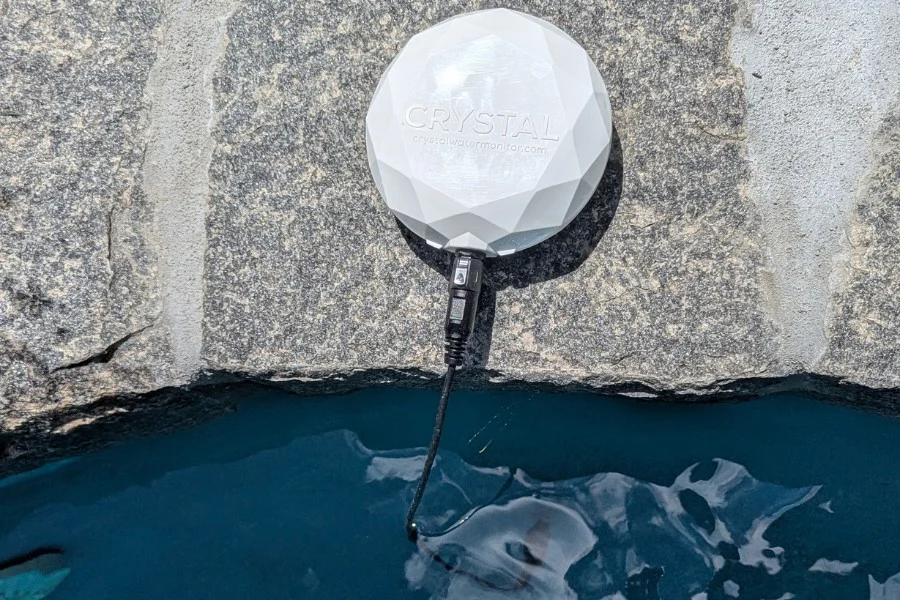
Over the years, there have been efforts to make pool testing simpler for pool owners. With advances in technology and AI, smart testing devices have started to enter the testing market.
Pool testing needs to be accurate and reliable so your water is safe and clean to swim.
The new and upgraded Crystal Water Monitor is a simple, yet technologically advanced monitoring device that can help you keep your water clear all season.
Disclosure: This product was provided to me by Crystal Water Monitor for testing. I have not been compensated for this review. All opinions expressed are my own. This post contains affiliate links.
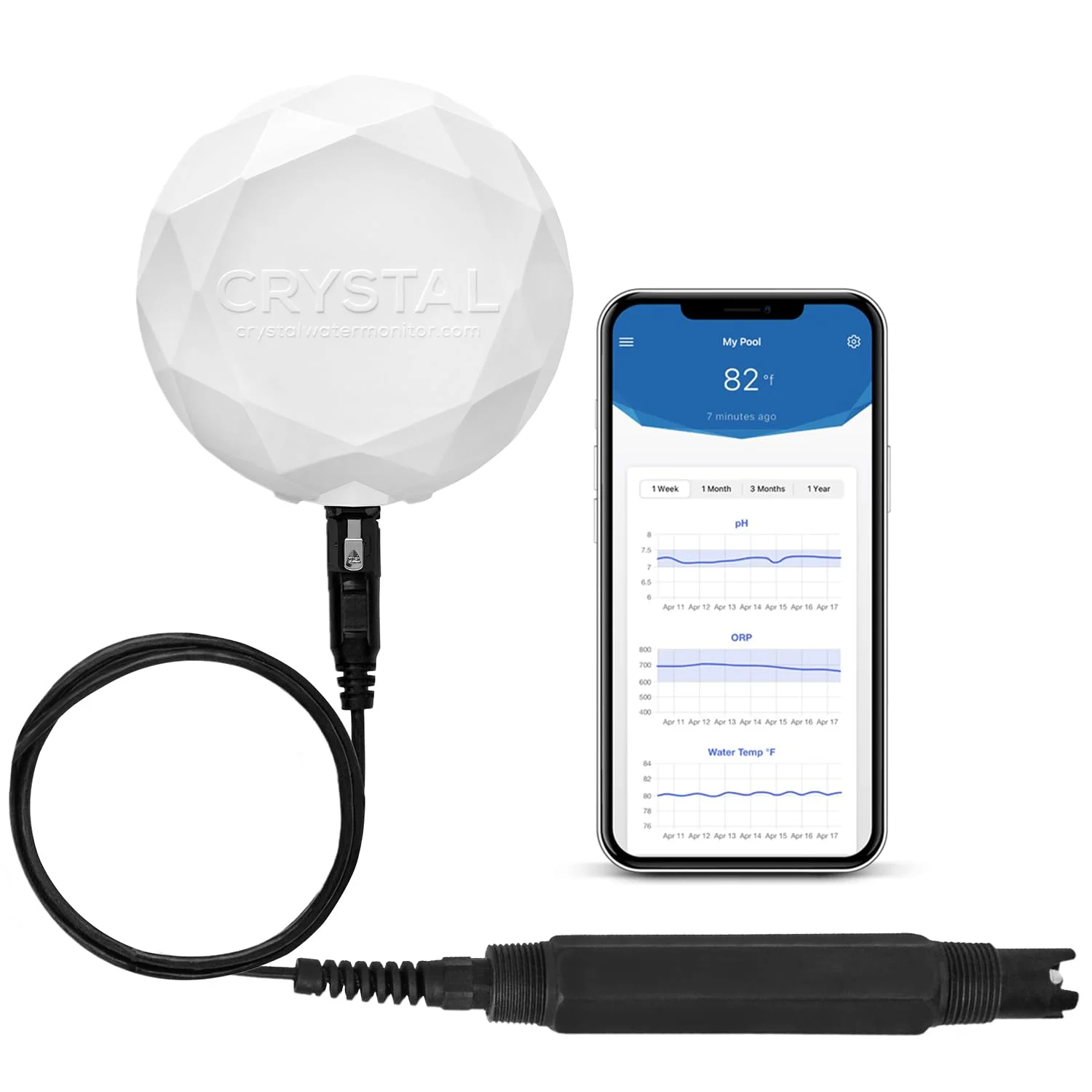
Crystal Water Monitor
While an expensive device, the Crystal Water Monitor will keep your water safe and healthy for swimming. You may need some extra knowledge to understand its output.
Pros
Cons
*By buying from these links, I may earn from qualifying purchases at no additional cost to you.
Crystal Water Monitor Overview
The Crystal Water Monitor describes itself as helping “maintain proper water chemistry in your pool or hot tub water by using intelligent sensors … providing insight into what chemicals you need to add to your pool or hot tub and how much.” It was created by the same folks who were behind the now-discontinued pHin device.
It works in both pools and spas / hot tubs and supports chlorine, bromine, or saltwater pools.
The Water Monitor measures pH, water temperature, & ORP levels, and measures your pool 144 times per day. That is a reading every 10 minutes, just over 1,000 tests per week. You should pretty much always know where your water chemistry stands daily.
The readings are recorded and shown in an easy-to-use app interface, with the ability to see readings over the past year.
Pricing and Subscription Costs
As of this review (May 2025), the chlorine/bromine version is $449 and the saltwater pool version is $479.
Once purchased, the first year of service and support is included. Afterwards, there is a $99 annual subscription fee that includes continued support and replacement sensors at no additional charge.
While you don’t need a subscription, the free version does not include replacement parts, historical charts, or alerts, among other things.
Understanding ORP
ORP may be a new concept for a pool owner to understand. While they are common with commercial pools, most smart devices utilize ORP testing.
ORP stands for Oxidation-Reduction Potential. It measures the ability of your sanitizer (primarily chlorine) to oxidize, or disinfect, organic contaminants in water. It doesn’t necessarily measure how much chlorine is in the water (like drop-based testers and test strips), but instead tells you how effective the chlorine is in killing bacteria and keeping the pool water safe.
It is measured in millivolts (mV) with a range from -700 to +700 mV. According to Crystal Water Monitor, the recommended value for a pool is between +650 and +750 mV.
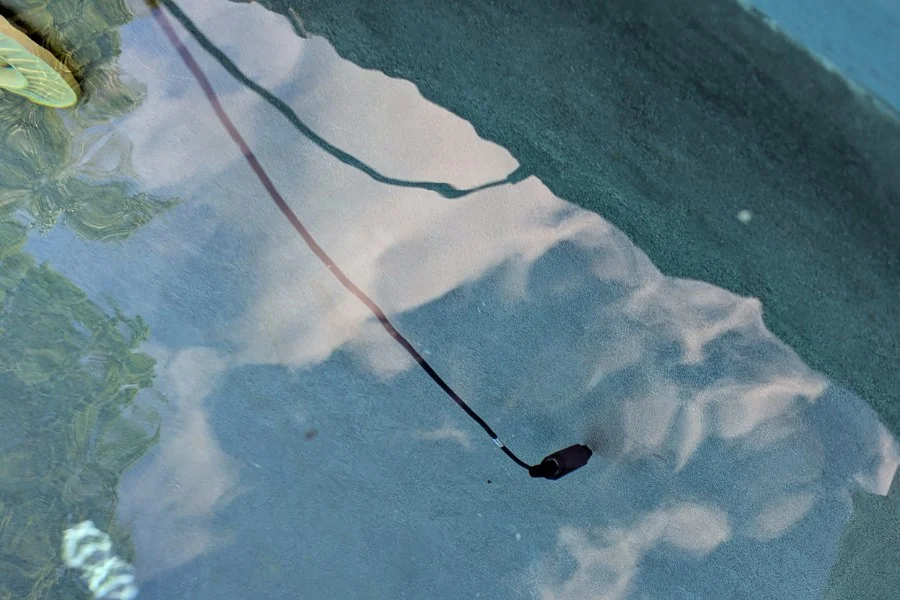
The effectiveness of the chlorine depends a lot on your pH and cyanuric acid (CYA) levels. If these levels get too high, your ORP reading can be lower because chlorine isn’t as effective at higher pH and CYA levels.
Basically, instead of looking at parameters individually at a snapshot, ORP is a combination of factors that looks at sanitizing levels in real-time.
Unboxing and Setting It Up in the Pool
The Crystal Water Monitor comes in a nice and compact box. I know it’s just a box, but I appreciate a company and brand that puts thought into every aspect of their product. The box is the very first thing a customer will see, and this is very professional.
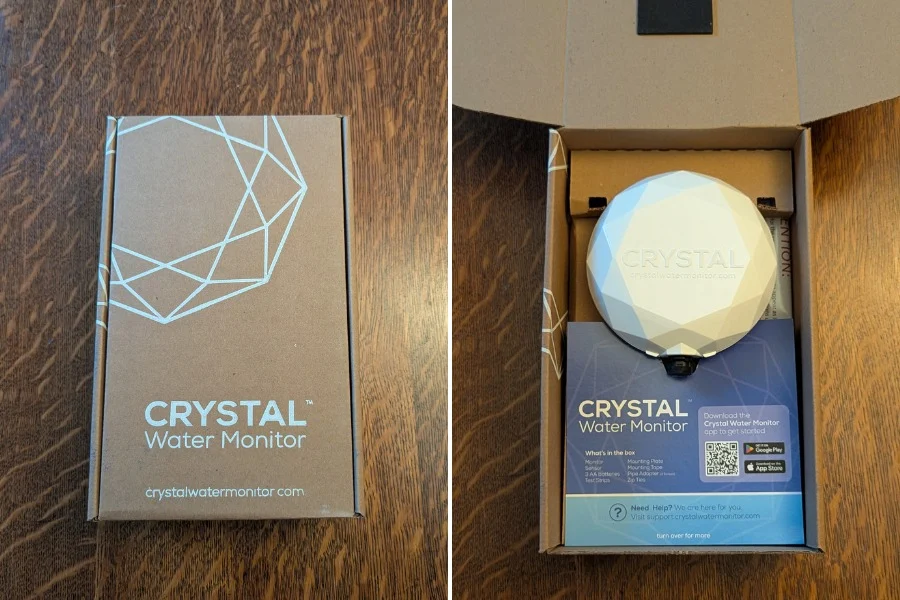
Inside the box includes:
- The Crystal Water Monitor and sensor
- 3x AA batteries
- A set of LaMotte Insta-Test 6 Plus test strips
- Mounting plate and tape
- Pipe adapter
- 2x cable ties
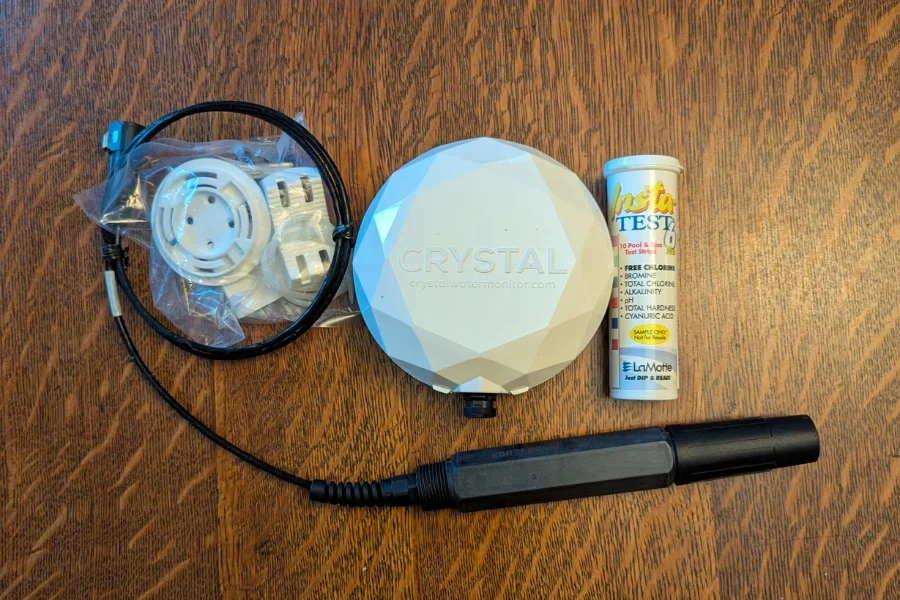
Setting up the device is extremely simple with step-by-step instructions through the app. After creating an account with my pool information, the process of inserting the batteries, connecting the device to WiFi (2.4 GHz network), and mounting it took 5-10 minutes. After that, your work is done, and the Monitor does its sampling.
What I like is that there is no hub or extra “middle-man” device to connect. The monitor itself is the hub. Every WiFi setup is different, but I had no trouble connecting and haven’t had any drops to date.
The biggest step in the setup is deciding where to mount the device. They give multiple mounting options depending on your pool. The most practical spot for my pool is directly onto the coping.
I tried tying it to my handrail, but the aesthetics of that, plus a black wire going into the poo, was not ideal
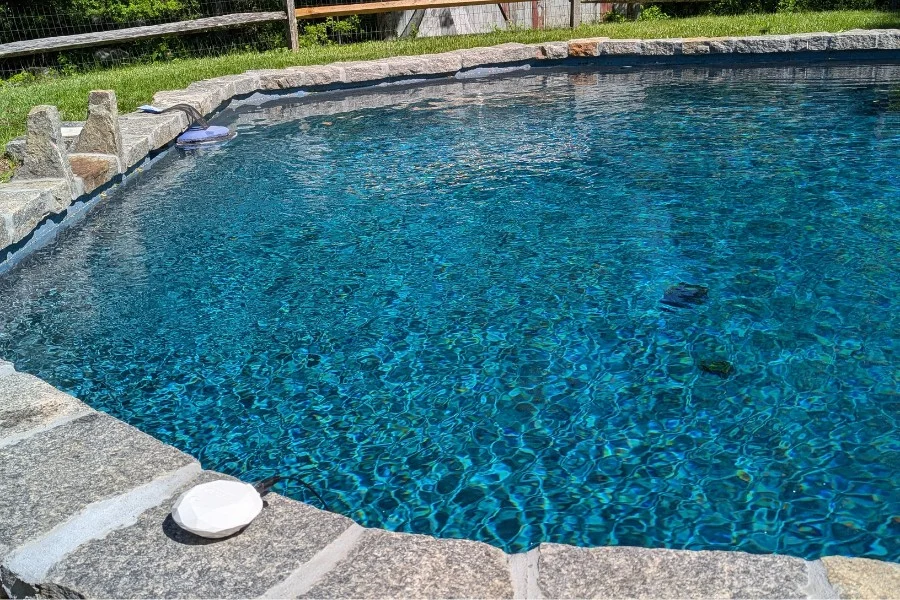
It was pretty hard, at least for my pool, to find a spot that would be out of the way visually but still be secure enough not to fall. I can imagine this may be the same for many pool owners.
The Crystal Water Monitor App
The app is super simple to use. I like the simplicity of it all as it tells you exactly what you need to know without any extra fluff.
The app’s home screen shows a large, Crystal Monitor-shaped icon that shows your current pool temperature and any recommendations from the last reading. A blue icon means the pool is balanced, and an orange icon means some parameters need adjusting.
I would like to see the ORP reading as the primary focus instead of the temperature. To me, it seems like temperature would be what I care about the least out of the three measurements.
After clicking on the icon, you’ll see the latest readings of pH, ORP, and temperature. Other items included are readings from manual tests (more on that below) and historical charts showing changes in your pH, ORP, and temperature.
There are also actions they recommend to get your water balanced. I wouldn’t be doing my duty, however, if I didn’t call out the action to shock the pool.
I am clearly on record of “shock when you have a water issue” and not having it be a weekly maintenance task. Fortunately, actions can be “snoozed” and ignored!
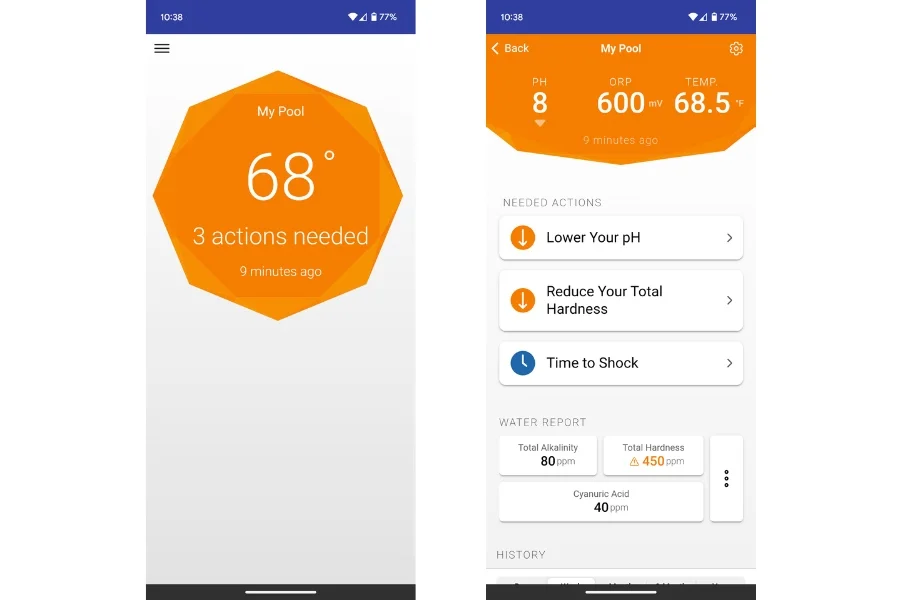
One aspect of the app I really appreciate is the deep links into Crystal Water Monitor’s support pages for additional information. While it gives the basic information on parameters and testing, there are links to more information if needed. I think the more information, the better, so this is definitely a plus in my opinion.
Performance of the Crystal Water Monitor
I harp on this a lot, but the health of your pool’s water is only as good as the testing itself. You need accurate and reliable testing to make sure the water is clear of contaminants and safe to swim in.
Though I’ve only had this device for a short time (not a full swim season yet), I haven’t had any significant issues.
Since it uses ORP readings and does not directly test chlorine and other parameters, I can’t really do those direct comparisons. However, pH levels were compared with a Taylor k-2006 testing kit and another smart device, the Sutro Pool Monitor.
Accuracy of Testing
The Crystal Water Monitor measures pH between 4 and 10 with an accuracy variance of +- 0.2. For the first week or so, my pH readings were consistently about 0.5 higher than the Sutro and Taylor kit. This caused my ORP readings to drop considerably.
After that, however, it seemed to settle within the range of its accuracy variance on the higher end. Except for a few outlier samples where results would shoot up to 8.4 then drop down in the next test, it’s been fairly consistent with other testers.
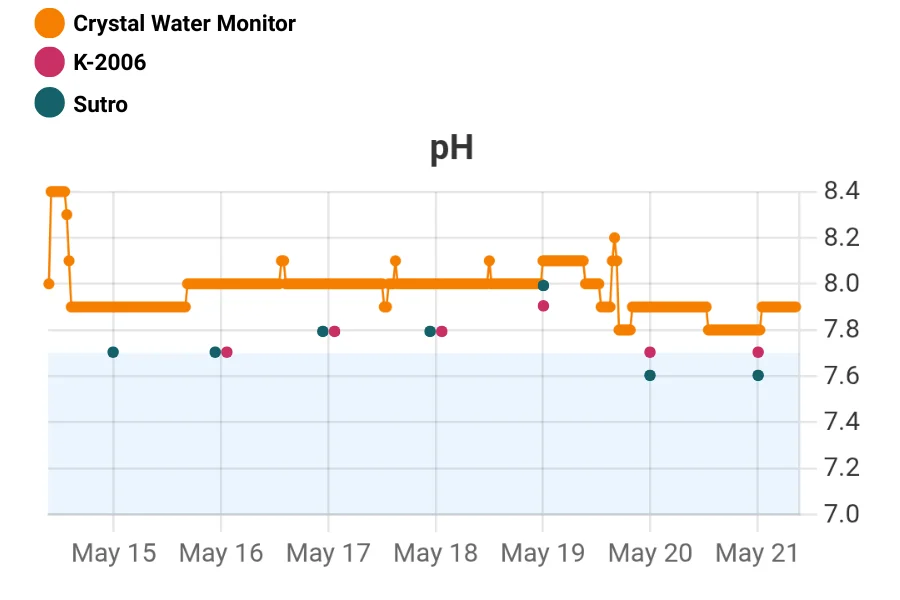
When I would add muriatic acid, chlorine, or other chemicals, the ORP levels would positively change to reflect these additions after a few minutes. Having those 144 daily tests allows you to be in the know literally at any time of the day.
Reliability of the Device
It has also been reliable with no hiccups over the period of time it’s been in use. No downtime or missed tests have been reported. Heavy rains and gusty winds also haven’t been an issue so far.
I have initial skepticism of the use of AA batteries, and only time will tell if that is warranted. However, support claims that a stable WiFi connection “should yield a battery life of approximately 1 year.” To note, they recommend using AA Lithium batteries.
I do wonder how it will hold up when it gets into the summer heat. My pool gets hit by the sun from 8 AM to 8 PM every day. The coping stones can get pretty hot as well, so that is something that I will monitor through the summer.
Chemical Treatments and Recommendations
One thing I have come to learn and read about ORP testing is that it is not very flexible when it comes to chemistry parameters. It is quite sensitive to pH and CYA changes in particular.
For me, my pool stays pretty consistent at a pH of around 7.8 throughout the swim season. I don’t tinker with it too much unless it hovers around 8. Total alkalinity is usually around 60-70 ppm. This works for my pool.
ORP drops as pH and CYA rise. Since I keep my pH on the higher end, my ORP readings tend to skew on the lower end of the recommended mV. This will also impact saltwater pool owners who tend to have higher pH and CYA levels.
With that said, I do appreciate the ability to add manual readings. You can even take a picture of a test strip and let the app detect the readings, which is pretty nifty.
I am not too fond of strips, so they also give you the option of entering results from a test kit.
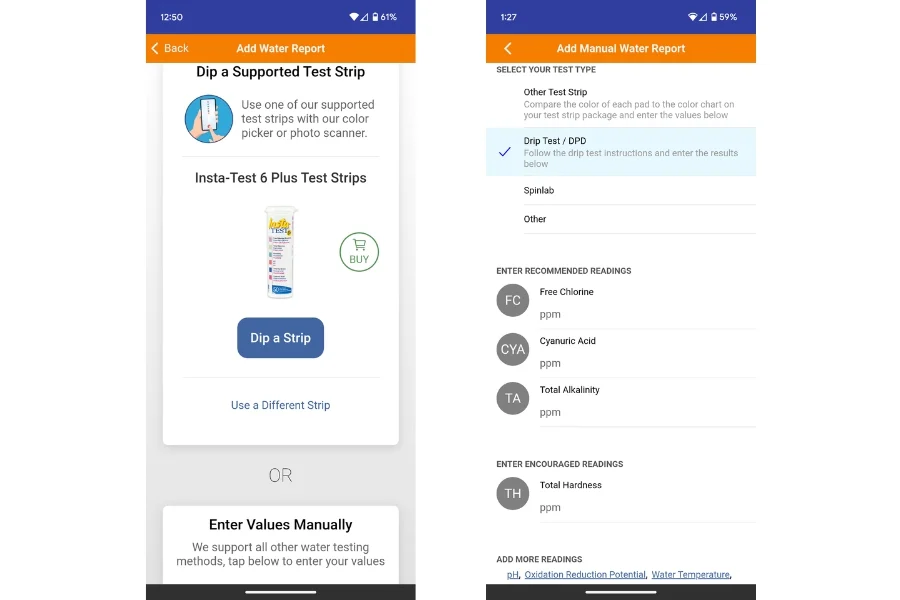
Also, I love the fact that you can add your chemical of choice for increasing and decreasing a parameter. Not only that, but if it isn’t on their list initially, you can scan the barcode and include the ingredients if necessary.
Even if you can’t find the chemical you use, there are plenty of options to at least choose one that has similar ingredients or percentages.

Is The Crystal Water Monitor Worth It?
There is no denying that pool equipment and accessories are expensive. But time is also expensive, and I understand that the average pool homeowner just does not have the time to be constantly testing their water manually on a daily or weekly basis.
While the upfront $449 cost and annual subscription are expensive, it gives you consistent, timely readings (every 10 minutes!) and chemical recommendations. The only thing for you to do is add the chemicals.
Because ORP values naturally fluctuate with pH, I’d still recommend using occasional traditional testing alongside the device to get the full picture of your water chemistry. But that doesn’t take away from the fact that this is a valuable device that will help you keep your water clean and safe for swimming.
Bottom line: it’s dependable, convenient, and worth it.
